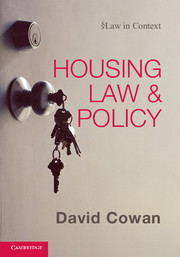Book contents
- Frontmatter
- Contents
- Preface
- List of abbreviations
- Table of legislation
- Table of international instruments
- Table of cases
- 1 Locating housing law and policy
- Part I Regulation of housing tenure
- Part II Access to housing
- Part III Rights and responsibilities
- 11 Security of tenure
- 12 Harassment and unlawful eviction
- 13 Property state and condition
- 14 Arrears
- 15 Anti-social behaviour
- 16 Mandatory possession proceedings
- Postscript
- Bibliography
- Index
15 - Anti-social behaviour
from Part III - Rights and responsibilities
Published online by Cambridge University Press: 05 June 2012
- Frontmatter
- Contents
- Preface
- List of abbreviations
- Table of legislation
- Table of international instruments
- Table of cases
- 1 Locating housing law and policy
- Part I Regulation of housing tenure
- Part II Access to housing
- Part III Rights and responsibilities
- 11 Security of tenure
- 12 Harassment and unlawful eviction
- 13 Property state and condition
- 14 Arrears
- 15 Anti-social behaviour
- 16 Mandatory possession proceedings
- Postscript
- Bibliography
- Index
Summary
To say that ASB has been a policy and legislative, as well as academic, focus for the past fifteen or so years would be an understatement. There have been a range of interventions – legislative and non-legislative – aimed at preventing further bad conduct and encouraging good conduct. Crawford (2009: 817–18) identified eighteen noteworthy ‘regulatory tools’ with ASB at their heart since 1996, not all of which were new, but which had been significantly expanded in scope and use in recent years. The relationship between ASB and housing, in particular, tenure, has been one of the cornerstones of this regulatory intervention, although it is also right to say that the policy rhetoric is now oriented in a more tenure-neutral way. Nevertheless, the discovery of, and interventions to deal with, ASB have lead to a seismic shift in the way housing tenure, specifically social housing, is managed and its residents controlled. These processes were already in place but have been magnified and intensified, and the evidence is that most of the interventions are used by social landlords and against their residents at the residents’ request.
This chapter begins by locating the definition of ASB at a broad level, narrowing down to its focus on tenure. One of the key questions here is why was it that social housing was initially targeted? Equally, the consequences of that focus at the level of housing management are discussed in this section, drawing attention to the recalibration of the housing management role. The next section begins with some of the ‘softer’, non-statutory regulatory tools in operation, moving on to the forms of injunction currently in operation, to the new form of social housing tenure (introductory and starter tenancies, the demoted tenancy and family intervention tenancy), and then to claims for possession based on nuisance, the close relative of ASB. The presentation of the material here is designed to reflect the rational, pyramid structure of interventions (Ayres and Braithwaite 1992); but it should always be borne in mind that such a neat structure is not always operationalised in practice, so that interventions can begin at the top of the pyramid. The final section, by way of conclusion, offers further observations.
- Type
- Chapter
- Information
- Housing Law and Policy , pp. 352 - 377Publisher: Cambridge University PressPrint publication year: 2011

